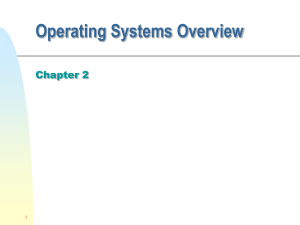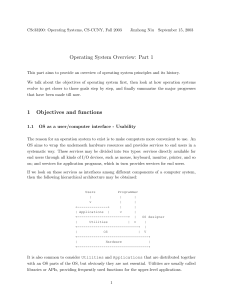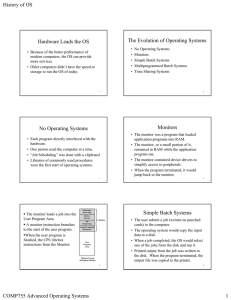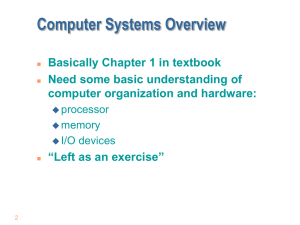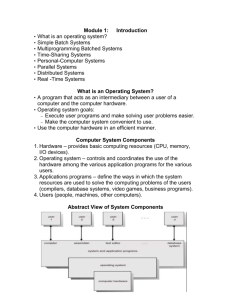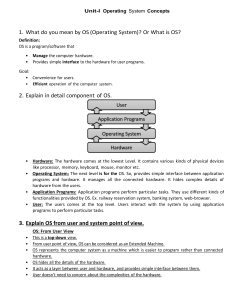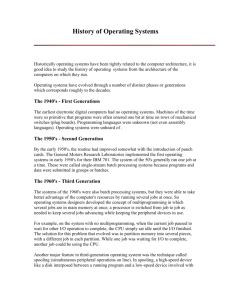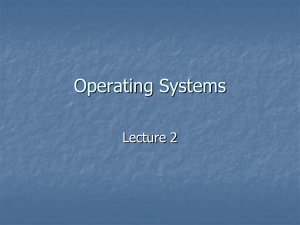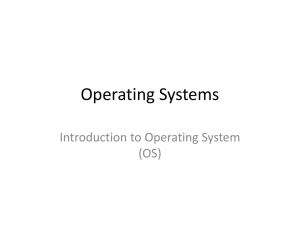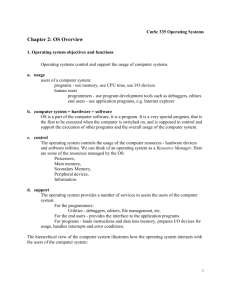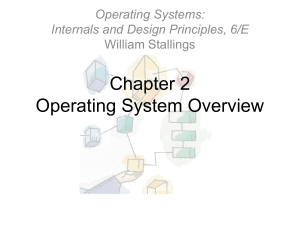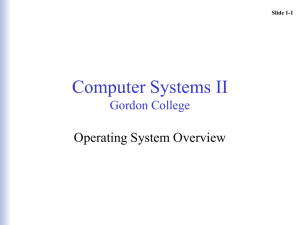Operating Systems Structure Chapter 2 Operating System Services
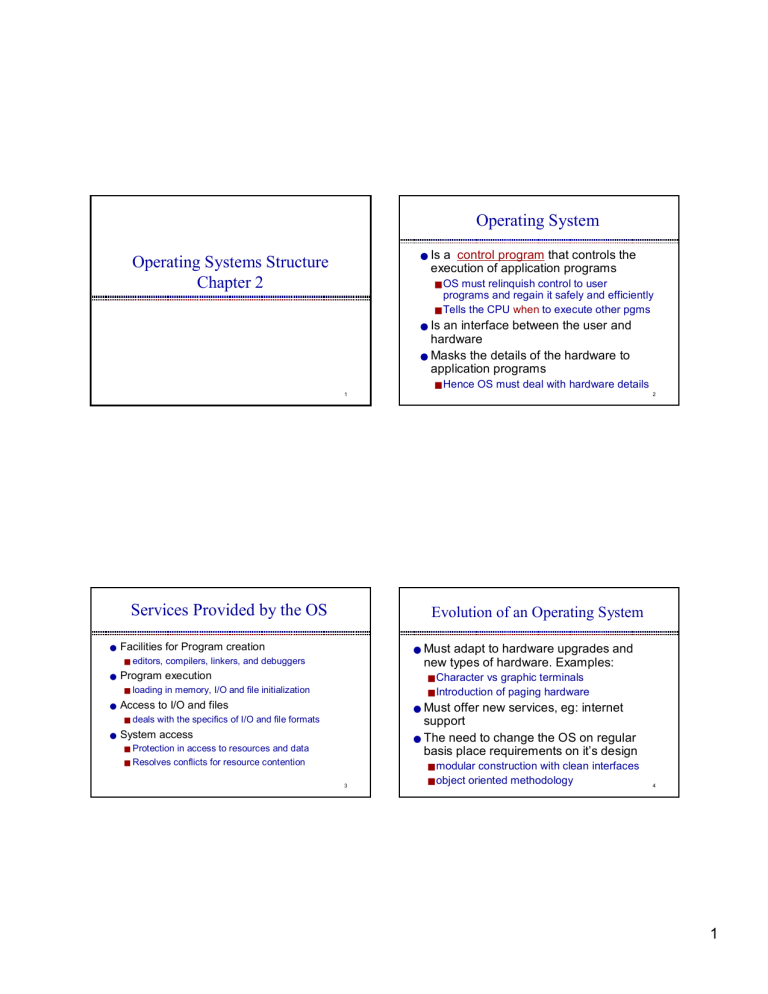
Operating Systems Structure
Chapter 2
1
Operating System
● Is a control program that controls the execution of application programs
■ OS must relinquish control to user programs and regain it safely and efficiently
■ Tells the CPU when to execute other pgms
● Is an interface between the user and hardware
● Masks the details of the hardware to application programs
■ Hence OS must deal with hardware details
2
Services Provided by the OS
● Facilities for Program creation
■ editors, compilers, linkers, and debuggers
● Program execution
■ loading in memory, I/O and file initialization
● Access to I/O and files
■ deals with the specifics of I/O and file formats
● System access
■ Protection in access to resources and data
■ Resolves conflicts for resource contention
3
Evolution of an Operating System
● Must adapt to hardware upgrades and new types of hardware. Examples:
■ Character vs graphic terminals
■ Introduction of paging hardware
● Must offer new services, eg: internet support
● The need to change the OS on regular basis place requirements on it’s design
■ modular construction with clean interfaces
■ object oriented methodology
4
1
Simple Batch Systems
● Are the first operating systems (mid-50s)
● The user submit a job (written on card or tape) to a computer operator
● The computer operator place a batch of several jobs on a input device
● A special program, the monitor , manages the execution of each program in the batch
● Resident monitor is in main memory and available for execution
● Monitor utilities are loaded when needed
5
The Monitor
● Monitor reads jobs one at a time from the input device
● Monitor places a job in the user program area
● A monitor instruction branches to the start of the user program
● Execution of user pgm continues until:
■
■ end-of-pgm occurs error occurs
● Causes the CPU to fetch its next instruction from Monitor
6
Job Control Language (JCL)
● Is the language to provide instructions to the monitor
●
■ what compiler to use
■ what data to use
Example of job format: ------->>
●
●
●
$FTN loads the compiler and transfers control to it
$LOAD loads the object code (in place of compiler)
$RUN transfers control to user program
$JOB
$FTN
...
FORTRAN program
...
$LOAD
$RUN
...
Data
...
$END
7
Job Control Language (JCL)
● Each read instruction (in user pgm) causes one line of input to be read
● Causes (OS) input routine to be invoke
■ checks for not reading a JCL line
■ skip to the next JCL line at completion of user program
8
2
Batch OS
● Alternates execution between user program and the monitor program
● Relies on available hardware to effectively alternate execution from various parts of memory
9
Desirable Hardware Features
● Memory protection
■ do not allow the memory area containing the monitor to be altered by user programs
● Timer
■ prevents a job from monopolizing the system
■ an interrupt occurs when time expires
10
Desirable Hardware Features
● Privileged instructions
■ can be executed only by the monitor
■ an interrupt occurs if a program tries these instructions
● Interrupts
■ provides flexibility for relinquishing control to and regaining control from user programs
11
Multiprogrammed Batch Systems
● I/O operations are exceedingly slow
(compared to instruction execution)
● A program containing even a very small number of I/O ops, will spend most of its time waiting for them
● Hence: poor CPU usage when only one program is present in memory
12
3
Multiprogrammed Batch Systems
● If memory can hold several programs, then
CPU can switch to another one whenever a program is awaiting for an I/O to complete
● This is multitasking (multiprogramming)
13
Requirements for Multiprogramming
● Hardware support:
■ I/O interrupts and (possibly) DMA
– in order to execute instructions while I/O device is busy
■ Memory management
– several ready-to-run jobs must be kept in memory
■ Memory protection (data and programs)
● Software support from the OS:
■ Scheduling (which program is to be run next)
■ To manage resource contention
14
Example: three jobs are submitted
Type of job
Duration
Memory req.
Need disk?
JOB1 JOB2
Heavy compute Heavy I/O
5 min.
15 min.
50K
No
100 K
No
JOB3
Heavy I/O
10 min.
80 K
Yes
Need terminal No Yes No
Need printer?
No No Yes
● Almost no contention for resources
● All 3 can run in minimum time in a multitasking environment (assuming JOB2/3 have enough
CPU time to keep their I/O operations active)
15
Advantages of Multiprogramming
Processor use
Memory use
Disk use
Printer use
Uniprogramming
17%
33%
33%
33%
Elapsed time
Throughput rate
30 min.
6 jobs/hr
Mean response time 18 min.
Multiprogramming
33%
67%
67%
67%
15 min.
12 jobs/hr
10 min.
16
4
Time Sharing Systems (TSS)
● Batch multiprogramming does not support interaction with users
● TSS extends multiprogramming to handle multiple interactive jobs
● Processor’s time is shared among multiple users
● Multiple users simultaneously access the system through terminals
17
Time Sharing Systems (TSS)
● Because of slow human reaction time, a typical user needs 2 sec of processing time per minute
●
Then (about) 30 users should be able to share the same system without noticeable delay in the computer reaction time
●
The file system must be protected (multiple users…)
18
System Structure
● Because of it’s enormous complexity, we view the OS system as a series of levels
● Each level performs a related subset of functions
● Each level relies on the next lower level to perform more primitive functions
● Well defined interfaces: one level can be modified without affecting other levels
● This decomposes a problem into a number of more manageable sub problems
19
Monolithic systems
●
●
●
●
●
Monolithic/layered system
All services provided by the OS
OS functionality provided by the
OS/kernel
Unix, VMS, Linux
Features
■ Easy to understand
■
■
■
Simplifies construction
Careful interface
Very rigid
20
5
Characteristics of Modern
Operating Systems
● New design elements were introduced recently
● In response to new hardware development
■ multiprocessor machines
■ high-speed networks
■ faster processors and larger memory
● In response to new software needs
■ multimedia applications
■ Internet and Web access
■ Client/Server applications
21
Microkernel architecture
● Support a minimal set of essential functions in the kernel
■ primitive memory management (address space)
●
●
■ Interprocess communication (IPC)
■ basic scheduling
● Other OS services are provided by processes running in user mode (servers)
■ device drivers, file system, virtual memory…
More flexibility, extensibility, portability…
A performance penalty by replacing service calls with message exchanges between process...
22
Advantages of kernelized design
● Supports heterogeneity
● Supports flexibility
● Supports extensibility
● Challenge- performance/security
23
6
